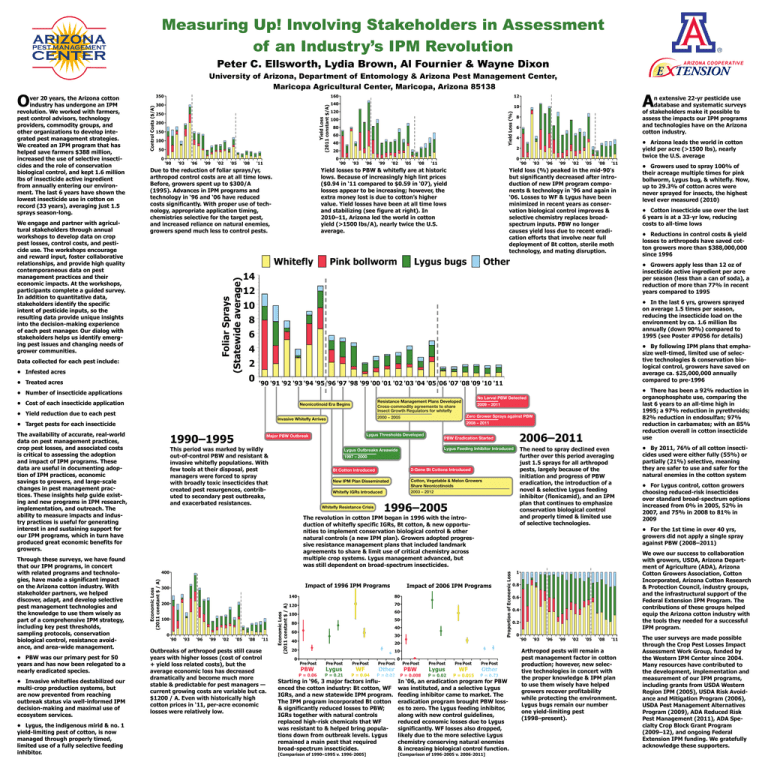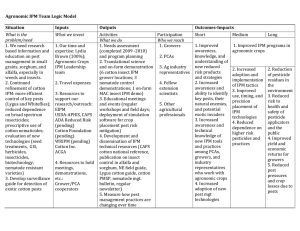Measuring Up! Involving Stakeholders in Assessment of an Industry’s IPM Revolution
advertisement

Measuring Up! Involving Stakeholders in Assessment of an Industry’s IPM Revolution Peter C. Ellsworth, Lydia Brown, Al Fournier & Wayne Dixon O ver 20 years, the Arizona cotton industry has undergone an IPM revolution. We worked with farmers, pest control advisors, technology providers, commodity groups, and other organizations to develop integrated pest management strategies. We created an IPM program that has helped save farmers $388 million, increased the use of selective insecticides and the role of conservation biological control, and kept 1.6 million lbs of insecticide active ingredient from annually entering our environment. The last 6 years have shown the lowest insecticide use in cotton on record (33 years), averaging just 1.5 sprays season-long. We engage and partner with agricultural stakeholders through annual workshops to develop data on crop pest losses, control costs, and pesticide use. The workshops encourage and reward input, foster collaborative relationships, and provide high quality contemporaneous data on pest management practices and their economic impacts. At the workshops, participants complete a guided survey. In addition to quantitative data, stakeholders identify the specific intent of pesticide inputs, so the resulting data provide unique insights into the decision-making experience of each pest manager. Our dialog with stakeholders helps us identify emerging pest issues and changing needs of grower communities. University of Arizona, Department of Entomology & Arizona Pest Management Center, Maricopa Agricultural Center, Maricopa, Arizona 85138 • Arizona leads the world in cotton yield per acre (>1500 lbs), nearly twice the U.S. average Due to the reduction of foliar sprays/yr, arthropod control costs are at all time lows. Before, growers spent up to $300/A (1995). Advances in IPM programs and technology in ‘96 and ‘06 have reduced costs significantly. With proper use of technology, appropriate application timing, chemistries selective for the target pest, and increased reliance on natural enemies, growers spend much less to control pests. Yield losses to PBW & whitefly are at historic lows. Because of increasingly high lint prices ($0.94 in ‘11 compared to $0.59 in ‘07), yield losses appear to be increasing; however, the extra money lost is due to cotton’s higher value. Yield losses have been at all time lows and stabilizing (see figure at right). In 2010–11, Arizona led the world in cotton yield (>1500 lbs/A), nearly twice the U.S. average. Yield loss (%) peaked in the mid-90's but significantly decreased after introduction of new IPM program components & technology in ‘96 and again in ‘06. Losses to WF & Lygus have been minimized in recent years as conservation biological control improves & selective chemistry replaces broadspectrum inputs. PBW no longer causes yield loss due to recent eradication efforts that involve near full deployment of Bt cotton, sterile moth technology, and mating disruption. • Number of insecticide applications • Cost of each insecticide application • Lygus, the indigenous mirid & no. 1 yield-limiting pest of cotton, is now managed through properly timed, limited use of a fully selective feeding inhibitor. 1990–1995 2008 – 2011 Lygus Thresholds Developed Major PBW Outbreak This period was marked by wildly out-of-control PBW and resistant & invasive whitefly populations. With few tools at their disposal, pest managers were forced to spray with broadly toxic insecticides that created pest resurgences, contributed to secondary pest outbreaks, and exacerbated resistances. 2009 – 2011 Zero Grower Sprays against PBW 2000 – 2005 Invasive Whitefly Arrives • Target pests for each insecticide No Larval PBW Detected Resistance Management Plans Developed Cross-commodity agreements to share Insect Growth Regulators for whitefly Neonicotinoid Era Begins • Yield reduction due to each pest • Invasive whiteflies destabilized our multi-crop production systems, but are now prevented from reaching outbreak status via well-informed IPM decision-making and maximal use of ecosystem services. • Reductions in control costs & yield losses to arthropods have saved cotton growers more than $388,000,000 since 1996 • By following IPM plans that emphasize well-timed, limited use of selective technologies & conservation biological control, growers have saved on average ca. $25,000,000 annually compared to pre-1996 • Treated acres • PBW was our primary pest for 50 years and has now been relegated to a nearly eradicated species. • Cotton insecticide use over the last 6 years is at a 33-yr low, reducing costs to all-time lows • In the last 6 yrs, growers sprayed on average 1.5 times per season, reducing the insecticide load on the environment by ca. 1.6 million lbs annually (down 90%) compared to 1995 (see Poster #P056 for details) • Infested acres Through these surveys, we have found that our IPM programs, in concert with related programs and technologies, have made a significant impact on the Arizona cotton industry. With stakeholder partners, we helped discover, adapt, and develop selective pest management technologies and the knowledge to use them wisely as part of a comprehensive IPM strategy, including key pest thresholds, sampling protocols, conservation biological control, resistance avoidance, and area-wide management. • Growers used to spray 100% of their acreage multiple times for pink bollworm, Lygus bug, & whitefly. Now, up to 29.3% of cotton acres were never sprayed for insects, the highest level ever measured (2010) • Growers apply less than 12 oz of insecticide active ingredient per acre per season (less than a can of soda), a reduction of more than 77% in recent years compared to 1995 Data collected for each pest include: The availability of accurate, real-world data on pest management practices, crop pest losses, and associated costs is critical to assessing the adoption and impact of IPM programs. These data are useful in documenting adoption of IPM practices, economic savings to growers, and large-scale changes in pest management practices. These insights help guide existing and new programs in IPM research, implementation, and outreach. The ability to measure impacts and industry practices is useful for generating interest in and sustaining support for our IPM programs, which in turn have produced great economic benefits for growers. A n extensive 22-yr pesticide use database and systematic surveys of stakeholders make it possible to assess the impacts our IPM programs and technologies have on the Arizona cotton industry. Lygus Outbreaks Areawide PBW Eradication Started Lygus Feeding Inhibitor Introduced 1997 – 2000 Bt Cotton Introduced 2-Gene Bt Cottons Introduced New IPM Plan Disseminated Cotton, Vegetable & Melon Growers Share Neonicotinoids 2003 – 2012 Whitefly IGRs Introduced Whitefly Resistance Crisis 1996–2005 The revolution in cotton IPM began in 1996 with the introduction of whitefly specific IGRs, Bt cotton, & new opportunities to implement conservation biological control & other natural controls (a new IPM plan). Growers adopted progressive resistance management plans that included landmark agreements to share & limit use of critical chemistry across multiple crop systems. Lygus management advanced, but was still dependent on broad-spectrum insecticides. Outbreaks of arthropod pests still cause years with higher losses (cost of control + yield loss related costs), but the average economic loss has decreased dramatically and become much more stable & predictable for pest managers — current growing costs are variable but ca. $1200 / A. Even with historically high cotton prices in ‘11, per-acre economic losses were relatively low. Starting in ‘96, 3 major factors influenced the cotton industry: Bt cotton, WF IGRs, and a new statewide IPM program. The IPM program incorporated Bt cotton & significantly reduced losses to PBW; IGRs together with natural controls replaced high-risk chemicals that WF was resistant to & helped bring populations down from outbreak levels. Lygus remained a main pest that required broad-spectrum insecticides. In ‘06, an eradication program for PBW was instituted, and a selective Lygus feeding inhibitor came to market. The eradication program brought PBW losses to zero. The Lygus feeding inhibitor, along with new control guidelines, reduced economic losses due to Lygus significantly. WF losses also dropped, likely due to the more selective Lygus chemistry conserving natural enemies & increasing biological control function. [Comparison of 1990–1995 v. 1996-2005] [Comparison of 1996-2005 v. 2006-2011] 2006–2011 The need to spray declined even further over this period averaging just 1.5 sprays for all arthropod pests, largely because of the initiation and progress of PBW eradication, the introduction of a novel & selective Lygus feeding inhibitor (flonicamid), and an IPM plan that continues to emphasize conservation biological control and properly timed & limited use of selective technologies. • There has been a 92% reduction in organophosphate use, comparing the last 6 years to an all-time high in 1995; a 97% reduction in pyrethroids; 82% reduction in endosulfan; 97% reduction in carbamates; with an 85% reduction overall in cotton insecticide use • By 2011, 76% of all cotton insecticides used were either fully (55%) or partially (21%) selective, meaning they are safer to use and safer for the natural enemies in the cotton system • For Lygus control, cotton growers choosing reduced-risk insecticides over standard broad-spectrum options increased from 0% in 2005, 52% in 2007, and 75% in 2008 to 81% in 2009 • For the 1st time in over 40 yrs, growers did not apply a single spray against PBW (2008–2011) . We owe our success to collaboration with growers, USDA, Arizona Department of Agriculture (ADA), Arizona Cotton Growers Association, Cotton Incorporated, Arizona Cotton Research & Protection Council, industry groups, and the infrastructural support of the Federal Extension IPM Program. The contributions of these groups helped equip the Arizona cotton industry with the tools they needed for a successful IPM program. Arthropod pests will remain a pest management factor in cotton production; however, new selective technologies in concert with the proper knowledge & IPM plan to use them wisely have helped growers recover profitability while protecting the environment. Lygus bugs remain our number one yield-limiting pest (1998–present). The user surveys are made possible through the Crop Pest Losses Impact Assessment Work Group, funded by the Western IPM Center since 2004. Many resources have contributed to the development, implementation and measurement of our IPM programs, including grants from USDA Western Region IPM (2005), USDA Risk Avoidance and Mitigation Program (2006), USDA Pest Management Alternatives Program (2009), ADA Reduced Risk Pest Management (2011), ADA Specialty Crop Block Grant Program (2009–12), and ongoing Federal Extension IPM funding. We gratefully acknowledge these supporters.


